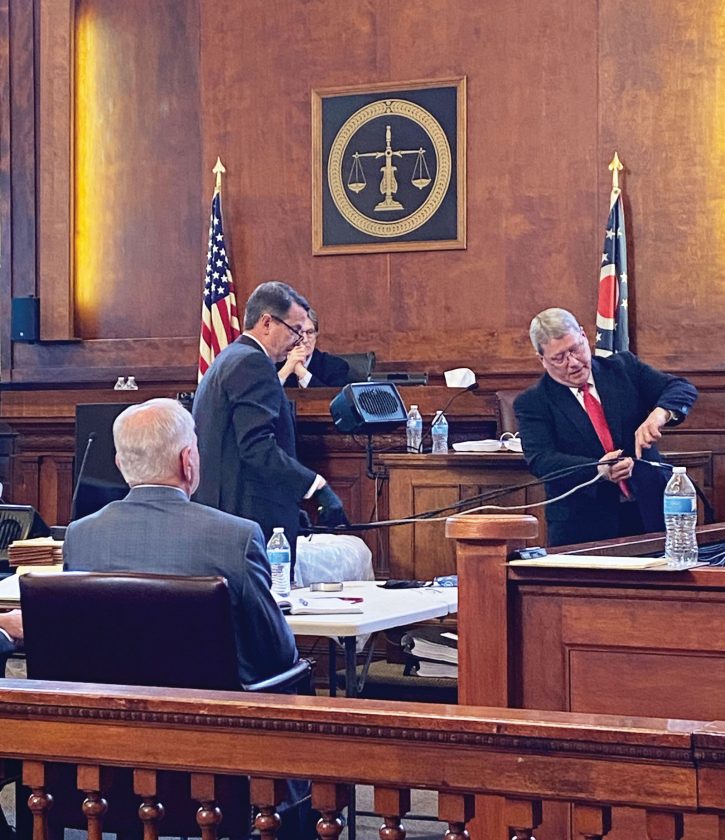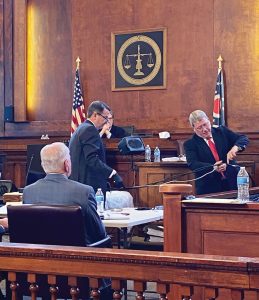Thompson wrongful death suit goes to jury
- The Washington County Common Pleas courtroom was packed Thursday for the final day of the trial in the wrongful death lawsuit the estate of Elsa Thompson filed against American Electric Power. Closing arguments and jury instructions were presented before the jury began deliberating. (Photo by Candice Black)
- Plaintiff’s attorney John Power and defense witness Nathan Bromen talk on Tuesday about the wires that were collected as evidence for the suit against AEP over the death of Elsa Thompson. (Photo by Candice Black)

The Washington County Common Pleas courtroom was packed Thursday for the final day of the trial in the wrongful death lawsuit the estate of Elsa Thompson filed against American Electric Power. Closing arguments and jury instructions were presented before the jury began deliberating. (Photo by Candice Black)
MARIETTA — The courtroom was packed with friends and family of Elsa Thompson, who died in a fire in 2019, to hear attorneys’ closing arguments in the wrongful death lawsuit filed by her estate against American Electric Power.
In May 2019, a storm caused a tree branch to fall on a power line near Thompson’s Marietta house. It was first reported on the afternoon of May 25, and a fire broke out later that evening around 11 p.m., resulting in her death.
Thursday saw the conclusion of arguments in the two-week trial filed by Thompson’s son, Andy, and carried on by her daughter Laura after his passing.
Alleged negligence on AEP and its employees as well as the personal responsibility of Elsa Thompson were some of the topics plaintiff’s attorney John Power and defense attorney Liz Moyo discussed with the jury.
“To this day, they refuse to accept responsibility. Now is the time, I’m going to ask you to go back there and finally find them responsible,” Power said. “Look at the effect on the community. It’s clear Elsa was a special lady.”

Plaintiff’s attorney John Power and defense witness Nathan Bromen talk on Tuesday about the wires that were collected as evidence for the suit against AEP over the death of Elsa Thompson. (Photo by Candice Black)
Power went over the events that led to the fire, AEP’s alleged negligence in responding to the hazard and the improper training of the linemen. It was Memorial Day weekend, and Power said AEP was not adequately staffed to account for the incoming storm.
He said Josh Vandergrift, the lineman who received the report of the downed wire, was not adequately trained because he did not know about the priority system which states known hazards are to be taken care of before “all out” calls.
“(They) deprived Josh of the priority policy. They never knew about it,” he said. “They clearly violated their duty to Elsa Thompson. They knew when there was an unsafe condition, they had a policy about it.”
When Vandergrift took the stand earlier in the week, Power said he testified that he responded to New Matamoras before Thompson’s house in Marietta because it was seven minutes closer.
Vandergrift, according to Power, had three chances to cut the power which experts agreed would have kept the fire from starting.
“She did what she was supposed to do, she followed their advice. If Josh Vandergrift had timely cut the power, we wouldn’t be here,” Power said.
Moyo started her closing argument by saying AEP is not changing its story. She reiterated statements during the opening arguments that AEP did their job, the cause of the fire was undetermined and there was a personal responsibility for Thompson.
She referenced AEP employee testimony that said they would not have responded any differently to calls that day.
“Josh’s instincts were right. His training was appropriate. He responded to outages where there was the greatest amount of risk to the greatest amount of people,” she said. “The plaintiff did not prove the cause of the fire. The plaintiff is not wanting to have any responsibility for what the conditions were inside her house.”
By not pruning the maple tree in her backyard, which was involved in downing the power line, or installing smoke detectors in her house, Moyo said Elsa Thompson did not “exercise reasonable care for her own safety.”
She explained that AEP’s job is to restore the outage that affects the most customers first.
“The primary outage creates the risk of people more than branches on a wire. Josh used good judgment when he turned left instead of right to address multiple customers who (had) power outages,” Moyo said. “The only evidence that AEP did not exercise the highest level of care are those cherry-picked portions of AEP’s documents that the plaintiff claims AEP did not follow.”
When linemen receive calls for service, Moyo said discretion is important and experience in the field should be taken into consideration.
“Dealing with an inherently dangerous substance ,(you) don’t want someone only responding from the document. We want them to use their training with electrical equipment,” she said. “AEP is not perfect but is made up of hardworking individuals like Josh who put themselves out there every day in dangerous situations.”
Fire investigator witnesses said the cause of the fire is undetermined. Of the 14 potential causes Nathan Bromen, who investigated the matter on behalf of AEP, discussed earlier in the week, Moyo said, he was only able to eliminate two.
Moyo then brought up the maple tree and the lack of smoke alarms in Thompson’s house.
“We’re not trying to blame Ms. Thompson for this tragedy that occurred. A reasonably careful person that knew for years that the tree was a risk would have addressed (it),” Moyo said.
Thompson’s house also caught fire in 2006, starting in the same area of the house, the family room. Moyo said after the 2006 fire, Thompson didn’t install smoke detectors.
“The lack of smoke alarms contributed to her death,” Moyo said.
Earlier in the day, Power said the jury should vote to award Thompson’s estate a total of $8 million for past and future mental anguish and loss of companionship, with an overall total of $11 million to $13 million for her pain and suffering.
Moyo talked about the family’s accomplishments and how she feels they were able to stay strong despite the tragedy of Thompson’s house.
“They do tell a story of a family that has stood strong during (a) difficult time. You should consider the good with the bad, the accomplishments with the struggles,” Moyo said.
AEP suggested the estate receive $400,000 to $700,000.
In a rebuttal, Power said Thompson’s family members are still struggling with her death.
“(They) are still on medication. You can hear their voices shaking when they talk about it. (Her daughter) still has nightmares,” he said.
As for the lack of smoke detectors, “she would have had three to five minutes to get out if she had smoke alarms. Three minutes, every second seems like an eternity,” Power said.
Members of the plaintiff’s attorney team put up a time clock that counted to three minutes. During those minutes, Power displayed photos of Thompson with her family members.
Specially appointed Judge Edward O’Farrell began the day by offering the jury instructions for how they are to deliberate and judge the facts presented. He said the jury was to decide whether AEP or Elsa Thompson were negligent, resulting in her death. At least six of the 12 jurors had to be in agreement on the verdict and the amount of money to be compensated to the estate.
O’Farrell said Thompson’s or AEP’s negligence would determine the verdict. The party whose negligence accounted for more than 50% of the cause of Thompson’s death, if the jury chose that direction of the verdict, would be at fault.
The jury had not reached a verdict as of deadline Thursday.
Candice Black can be reached at cblack@newsandsentinel.com.








